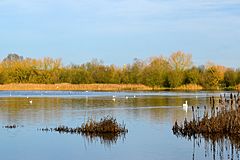Irthlingborough Lakes and Meadows facts for kids
Quick facts for kids Irthlingborough Lakes and Meadows |
|
|---|---|

View looking North across Corner Lake
|
|
| Lua error in Module:Location_map at line 420: attempt to index field 'wikibase' (a nil value). | |
| Location | Irthlingborough, Northamptonshire |
| Area | 117 hectares (290 acres) |
| Created | 2012 |
| Operated by | Wildlife Trust for Bedfordshire, Cambridgeshire and Northamptonshire |
| Status | Open all year |
| Website | http://www.irthlingboroughlakesandmeadows.org |
Irthlingborough Lakes and Meadows is a special nature reserve in Northamptonshire. It covers about 117 hectares (that's like 290 football fields!). The Wildlife Trust for Bedfordshire, Cambridgeshire and Northamptonshire looks after this amazing place.
This reserve has many flooded gravel pits and wet grasslands. These areas are perfect homes for lots of different plants and animals that love wetlands. It's part of a bigger important area called the Upper Nene Valley Gravel Pits Site of Special Scientific Interest (SSSI) and a Special Protection Area.
Irthlingborough Lakes and Meadows is close to other nature reserves, like Higham Ferrers Pits and Ditchford Lakes. This helps wildlife even more by creating large, connected protected areas.
Contents
History of the Reserve
This area used to be water meadows and farm fields next to the River Nene. But it has changed a lot over time.
Early Changes: Railways and Mining
The first big change happened in 1845 when the Northampton and Peterborough Railway was built. While building the railway, workers found ironstone in the Nene Valley.
Later, during World War I in 1916, a company started mining ironstone here. They dug up about 6,000 tons of ore every week!
From Gravel Pits to Lakes
The biggest change to the landscape began in the 1970s. Companies started digging out huge amounts of sand and gravel from the Nene Valley. An electric conveyor belt was built along the old railway line to move the materials.
By 2002, when the digging stopped, over 1.5 million tons of aggregate had been taken from the area. The large holes left behind then filled with water, creating the beautiful lakes and channels you see today.
A New Beginning for Wildlife
In 2012, the Wildlife Trust for Bedfordshire, Cambridgeshire and Northamptonshire bought this area. They got help from a special grant and donations from people. Now, the reserve is a key part of their Nene Valley Living Landscapes plan.
To make the reserve even better for wildlife, many improvements have been made. These include creating new islands for birds and removing unwanted plants and old electricity pylons.
Amazing Wildlife at the Reserve
The Nene Valley is one of the most important wetland areas in England. It's known around the world as a resting spot for thousands of wildfowl and wading birds that visit in winter. The types and numbers of birds change with the seasons.
Birds You Might See
During winter, you might spot these birds at Irthlingborough Lakes and Meadows:
- Golden Plover (Pluvialis apricaria)
- Wigeon (Anas penelope)
- Gadwall (Anas strepera)
- Tufted duck (Aythya fuliginosa)
Special Plants
Around the river and lakes, you can still find parts of rare meadows. These meadows are perfect for plants like Meadowsweet, great burnet, and the beautiful common spotted orchid.
How the Reserve is Managed
Different methods are used to help the wildlife at Irthlingborough Lakes and Meadows thrive. In the wetland areas, ditches are cleaned regularly. Unwanted bushes are removed, and trees are trimmed to keep the gravel pits open.
The grasslands are grazed by animals and cut at different times. This helps create a mix of grassland and scrub habitats, which is great for many different species.

